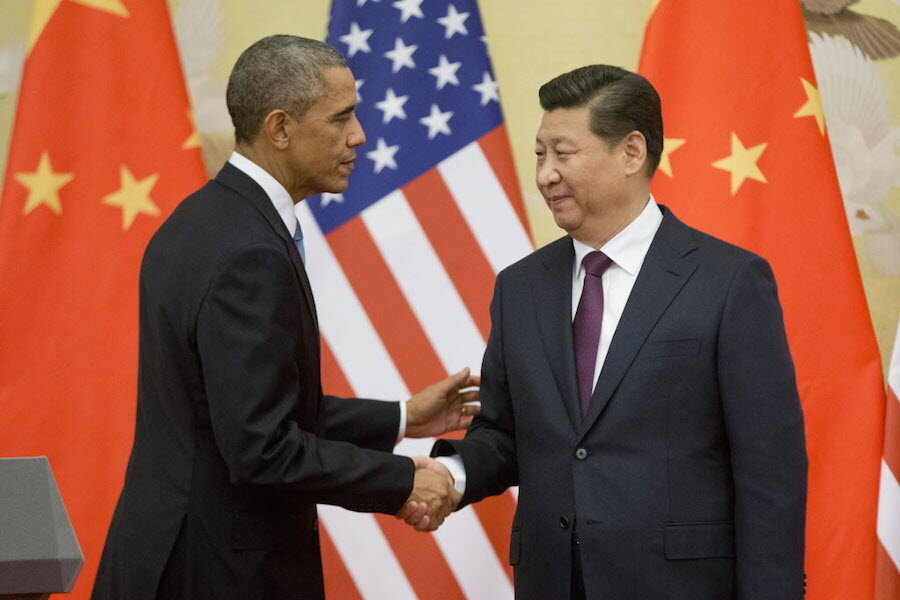It's official: China pledges ambitious goal toward UN climate deal
Loading...
| Washington
China is far and away the world’s No. 1 carbon polluter. But the nation of 1.4 billion is also among those leading the charge to curtail planet-warming emissions.
China formally submitted an emissions-cutting pledge to the UN Tuesday, including a goal of peaking its greenhouse gas output by 2030. After that, the rapidly growing country will slash the amount of carbon dioxide it releases from automobiles, coal-fired power plants, and factories.
Tuesday’s pledge is China’s offering toward a global deal that negotiators are hashing out to limit planet-warming emissions, which are changing weather patterns, melting polar ice caps, and raising sea levels. World leaders will finalize the deal at talks in Paris this December.
The question, though, is whether China and other countries’ emissions cuts will be enough to keep temperatures from rising more than 2 degrees Celsius above pre-industrial levels. Scientists say warming beyond that threshold could be catastrophic, but the International Energy Agency says emissions are on track to blow past the 2 degree goal.
Still, there's hope that China’s eagerness to engage in this round of climate talks could push world leaders to commit to a strong agreement – and one that can be updated in the future, to encourage deeper emissions cuts down the road.
"The announced targets are important indicators of countries’ intentions," says Bob Perciasepe, president of the Center for Climate and Energy Solutions, an Arlington, Va.-based think tank, in a statement Tuesday. "But the numbers will be much more meaningful attached to an agreement that holds countries accountable for their promises. That’s what Paris must deliver."
When climate talks faltered in Copenhagen in 2009, it was in part due to US and Chinese reluctance to sign on to binding emissions cuts. This time, China has built momentum for a deal, and has increasingly found common ground with the US and EU on climate challenges.
In fact, climate change is one of the few bright spots at a fractious time in China-US relations. Chinese militarization in the South China Sea and mistrust over cyberattacks have strained relations. But the Iran nuclear deal and climate change provide for common ground.
"We have agreed with the Chinese that we are going to try to expand those areas where our interests overlap and expand cooperation in those areas," a senior State Department official said at the US and China's annual strategic and economic dialogue last week.
In November, the US and China announced a historic bilateral climate accord, when China first pledged to peak its emissions by 2030. The country also agreed to get 20 percent of the energy it consumes from non-fossil fuel sources by 2030 – more than double 2013 levels, when 8.8 percent percent of energy consumption was from sources other than fossil fuels.
A London School of Economics (LSE) study earlier this month bolstered hopes that China was on track to peak its emissions as early as 2025.
“A 2025 peak is within reach,” says Valerie Karplus, a professor who studies Chinese energy and climate policies at the Massachusetts Institute of Technology, in an email to the Monitor. “However, there is significant uncertainty in the timing of any peak – which China's existing target acknowledges,” added Ms. Karplus, who was not involved in the LSE study.
China pumps out nearly a quarter of the world’s planet-warming gases, according to the US Environmental Protection Agency, meaning the country’s efforts to rein in emissions play an outsize role in combatting climate change.
With China’s formal pledge toward the UN climate talks, promised cuts are on the table for the lion’s share of the global emissions pie. Together, China, the US, and the EU represent more than half of global emissions. Add in Russia and Canada, who have also put forward climate pledges, and cuts have been announced for a sizable share of the global emissions.
But there are 196 countries in the world, and so far only 40 have pledged emissions cuts towards December’s climate talks in Paris. Of those 40 countries, 28 are part of the European Union. That means a large chunk of the world has yet to post its cuts – including India, which emits about as much as Russia. Those emissions are only projected to grow as India continues to industrialize.





